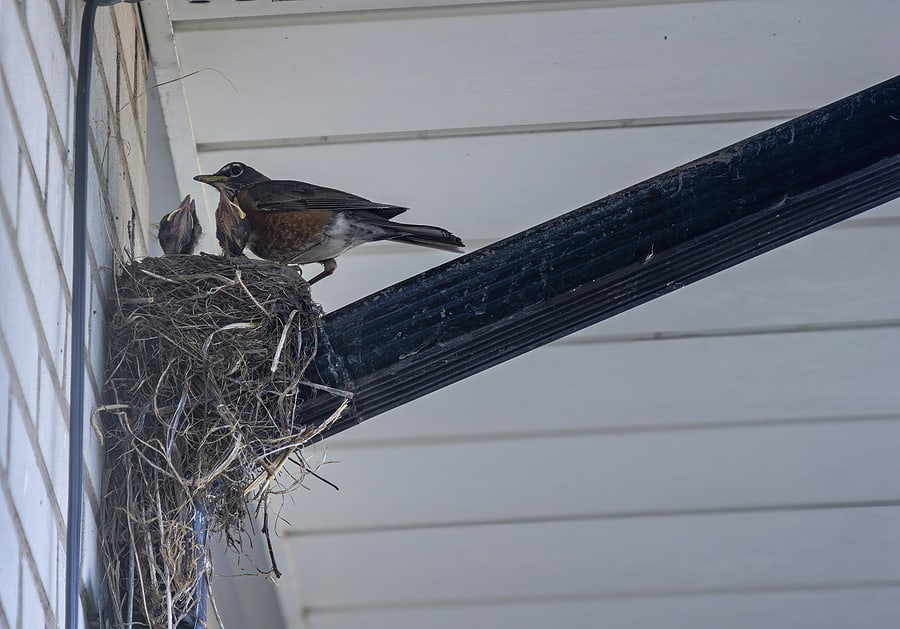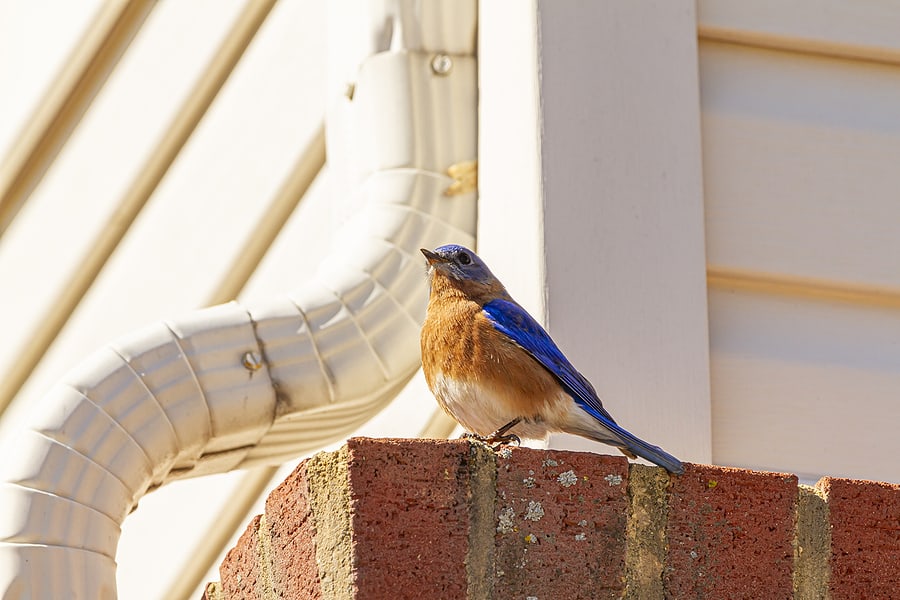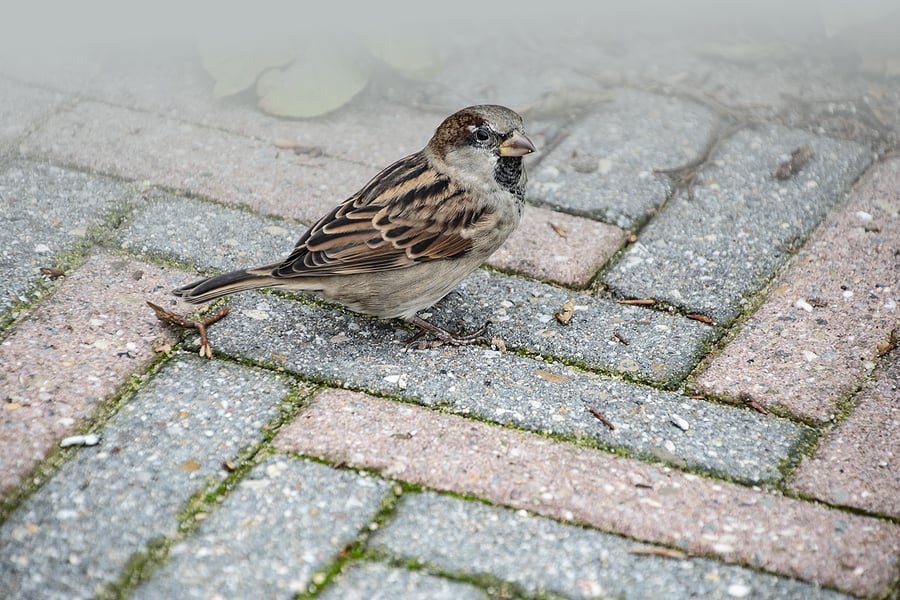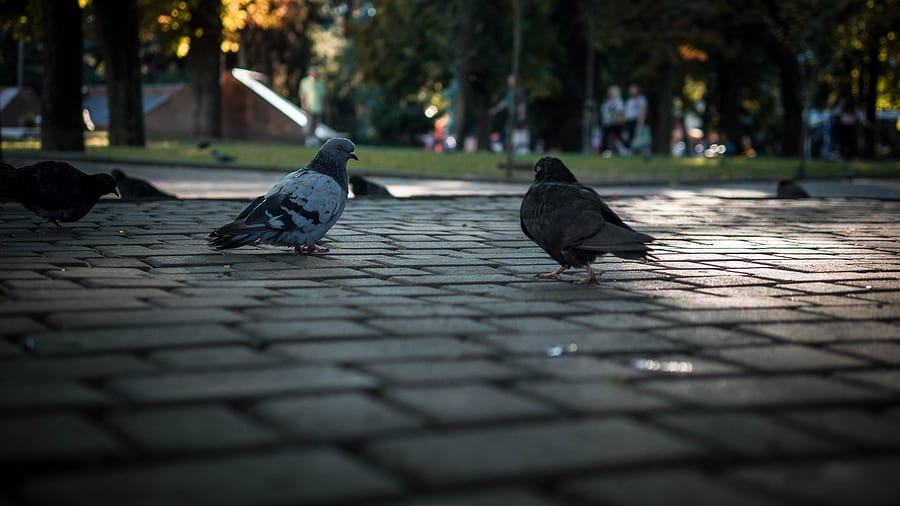READY TO GET STARTED?
REQUEST A FREE ESTIMATE
Fill out the form below or call (888) 466-7849 for a free, no-obligation estimate.

Did you know birds can be just as much of a nuisance (and potential health threat) as roaches and rodents? Common nuisance birds include pigeons, woodpeckers, sparrows, starlings, and Canadian geese.
Birds can cause a whole host of problems around your home and property. They can fly into your home and windows. They can build nests on or near your home, causing damage to your house or just being a noisy pest. Nests can clog gutters, downspouts, drains, vents, and chimneys. Bird droppings contain uric acid and can eat away at paint and building materials on cars and homes.
Birds and their droppings are known to carry over 60 diseases including E. coli, salmonellosis, and cryptococcosis.
Anytime you’re dealing with birds it’s important to remember that many species are protected by federal and/or state regulations, as is bird nest removal.
Visual bird deterrents are products designed to scare off birds or prevent them from landing or roosting where you don’t want them to. Their efficacy depends on the type of bird you are dealing with and the type of deterrent you are using. There is a wide range of choices when it comes to these deterrents. Many include gel because its reflective surface looks like fire to birds. It also feels sticky if birds land on it. Some of these deterrents are also scented, many with peppermint oil, to also help deter birds from getting near them.
Predator decoys can be effective for a short period of time but aren’t usually good for long-term use. It is important to choose a realistic predator for the bird species you are dealing with. If owls aren’t a natural predator of the bird you are dealing with, a decoy owl won’t work very well. It is also important to rotate or move the decoy frequently so birds don’t realize it isn’t real.
There is a wide range of products you can use as a reflective deterrent, from prefabricated spirals to DIY aluminum foil strips. The most important thing to remember is to use something highly reflective that also moves with the wind. It also helps to move it around frequently or even take it down for a while to trick the birds into thinking it’s real.
These are narrow spikes that attach to window sills, roofs, eaves, or any other large areas you want to keep birds off of. They can attach to concrete, wood, or other surfaces with screws or glue. The spikes can be metal or plastic. These deterrents are most effective against pigeons, crows, and gulls and are less effective against smaller types of birds.
Bird coils are similar to spikes. They are extendable stainless steel coils that stretch along ledges to deter birds from landing on them. If they do, the coils move and make the bird feel unstable, making them less likely to perch and roost.
Bird wire is a tension wire system that creates an unstable landing area to deter birds from landing. Bird wire is more low profile compared to spikes or coils and can be used on exposed ledges, beams, and pipes. The negative to bird wire is that it can be time-consuming and difficult to install.
Bird netting is commonly used in gardens or on fruit trees but can also be used under roofs and around eaves. Bird netting is less expensive than other deterrent methods. It is important to remember when installing bird netting that you don’t cut out sections of the net to fit around obstructions; instead, cut a slit in the netting, slide the obstruction through it, and then reseal it when it’s above the object. One negative to netting is that birds can get stuck in the net.
Birds usually come to your home or yard in search of a nesting site, food, or water. Eliminating these things will make your property less appealing to them. Install bird netting over gardens to keep them from getting to your fruit. Keep trash cans covered. Clean your gutters to prevent standing water or install gutter guards. Don’t use birdfeeders in the warmer months. If you do use birdfeeders, don’t use suet or corn in them. Instead, replace with whole peanuts, safflower seeds, or sunflower seeds in the shell.
The best way to keep birds out of your home is to make sure they don’t have a way in. Carefully inspect the exterior of your home or other outbuildings and seal any openings you find, especially those that lead to the attic. Block any openings to eaves or vents with 1/4″ wire mesh or netting.
Bird and bird nest removal can be a difficult (and sometimes illegal) job. If you have a problem with birds this season, contact your local pest control company who can properly identify the types of birds you are dealing with, along with the most appropriate elimination and prevention methods for you.
What Attracts Snakes to Your Yard?

Birds have been known to build their nests in the most inconvenient places around your home – above doors, over your garage, inside your shed, on top of your lawnmower, in heat pumps, and any number of other high traffic or hazardous areas. Although birds don’t typically pose a serious threat to humans, they can cause damage to your roof, car, and property. Their nests can block stove, dryer, and fan vents causing fire hazards and rendering them useless. Their nests can also clog gutters and drains, leading to standing water and potential damage to your roof. Their droppings contain uric acid which can damage the paint on your car. Bird droppings also contain pathogens that are dangerous to humans like histoplasmosis. Bird nests can also contain other pests such as mites, parasites, and ticks that can stick around long after the birds have left the nest.
Your first reaction when encountering a nuisance bird may be to just remove the nest. However, there are Federal laws regarding bird nest removal that make it illegal to remove certain species of birds or their nests. Best practice is always to check with a wildlife control company before attempting to remove any bird nests from your home.
Here are some steps to take to ensure both proper and safe bird nest removal and/or relocation.
The best way to eliminate bird nests from your property is to prevent them from building in the first place. Remove any food scraps and open trash from around your home as this invites them to feed. Make sure trash is secured tightly in containers. Place any bird feeders and birdbaths away from the home and further out in the yard. Only put out enough food for a few birds and clean up any spills regularly. Consider installing gutter guards to prevent nesting in gutters and downspouts. Vents are a common nesting place for birds so install vent covers and screens. Use perch repellents if necessary; these are rows of bird spikes installed on ledges, window sills, and around the perimeter of the roof to prevent birds from alighting on perches. You can also use visual repellents such as plastic owls, hawks, snakes, and even coyotes. If you use visual repellents, make sure to move them often as the birds will get used to them being in one place. Hang reflective bird diverters from strings on your porch also.
The best time to remove a nest is when it is still in the building stage. If you notice a bird nest already built or remove one this season, keep an eye out in the same area next season and stop it before it is fully completed.
Always make sure a nest is inactive before removing or relocating it. Never attempt to remove or relocate a nest if there are birds or eggs present. It is best to wait until after nesting season for any removal or relocation. Eggs in a nest without signs of the parents don’t necessarily mean the nest has been abandoned. The parents may be out feeding or they may have left to allow the eggs a chance to cool down.
The best time to remove or relocate a nest is after nesting season is over. Most birds only nest once per year; however, some species will nest 4 to 5 times. The time varies with the species of bird. Without knowing the specific species of bird, it is difficult to determine the best time to remove or relocate the nest. A professional wildlife exclusion expert can help identify the species you are dealing with and help determine the best time to remove the nest.
Once you have positively identified the species of bird you have, confirmed it is legal to remove the nest, and have made sure the nest is inactive and no eggs are present, you can proceed with removing or relocating the nest. Bird nests can harbor other pests and residual bird droppings that can contain dangerous pathogens for humans. Make sure to wear long sleeves, long pants, latex gloves, and a respiratory mask to protect yourself. Carefully inspect the nest to make sure it is empty of eggs and birds. Spray the nest with an antibacterial spray. Once dry, remove the nest and dispose of it in a securely sealed container or exterior trash bag. Dispose of it in the trash away from the home. Clean the area where the nest was with a strong disinfectant. Remove and dispose of your gloves. Remove your clothing and wash them immediately in hot water. Wash your hands thoroughly.
It can be difficult to determine whether or not the bird nest in or on your home is legal to remove or the best way to remove it. If you have a bird nest that is causing problems in or on your property, contact a professional wildlife exclusion company who can positively identify the species of bird you have, properly remove or dispose of the nest, and help you identify areas where nesting could be a potential issue in the future.
Can You Have Rats and Mice at the Same Time?
Wildlife Creatures to Lookout for this Winter

As the weather starts to warm up, you may see an increase in bird activity around your home. Birds will often leave a mess on your patio or deck and can even be found taking a dip in your swimming pool. Nuisance birds will build nests in the most inconvenient places putting you and your family in harm’s way. Here are a few tips on how to prevent birds from taking over your outdoor fun this summer.
There are several things you can try to keep birds away from your pool and deck. One of the easiest is to install a decoy bird near your pool. Owl statues are the most common but hawks and falcons will also work well. These statues make other nuisance birds think a predator has already claimed that territory and they will take up residence somewhere else. Remember to move the statue occasionally, especially if birds get used to it or start ignoring it.
You can also use automatic pool vacuums in your swimming pool to help deter birds. Automatic vacuums are constantly moving which discourage birds from landing in the water. Leaving brightly colored toys and floats in the pool can also help keep these pesky birds away. Keep your pool covered if possible. You can even use a simple solar cover instead of a traditional cover to help protect your pool from droppings and feathers.
Birds will often nest in your grill or in the eaves around your patio. To protect your grill in between uses, invest in a high quality cover and use it any time the grill is not in use. If that’s not an option, cover your grill with bird netting when it’s not in use. Clean the grill after use and make sure there is no food residue left over. Birds will keep coming back if they continue to find food in the area.
If you’re finding birds flocking to your deck or patio area, try installing bird spikes on fences or in gutters. It is difficult for birds to land on them, making it undesirable for birds to nest. You can also try wind chimes or ultrasonic noise machines which are also helpful and driving nuisance birds away. The noise machines give off a high-pitched sound that is undetectable to humans but will annoy any lingering birds.
Taking preventative measures against birds will help in your bird control efforts. Discourage people from feeding birds in and around your home. Clean up any spilled grain or birdseed from feeders daily. Block any openings in your home (lofts, vents, eaves, window sills, etc.). Change your ledge angles to 45 degrees or more to prevent birds from roosting on them. Screen the underside of rafters with netting or wire mesh screening.
While birds aren’t usually a dangerous problem, they can become quite a nuisance, especially when you are trying to enjoy time outdoors. If you have a problem with birds or any other pests, contact your local pest control company who can provide you with a thorough evaluation and treatment plan.
Does Hot Weather Bring Out Cockroaches?

Most of the time birds are fun to watch, singing their cheerful songs as they fly around our yards. Birds can also be productive by producing down feathers, helping control pests and weeds, and giving us plenty of opportunity for birdwatching. Some birds, however, are referred to as nuisance birds and can actually be detrimental to both our health and our homes by damaging buildings and monuments, contaminating our food sources, and transmitting serious diseases to humans.
Three of the most common nuisance birds are starlings, sparrows, and pigeons.
Starlings are found in both urban and rural areas. They travel in flocks that can have thousands of birds in them. They can often be found nesting in trees, vents, ledges, lampposts, and even signs. Starlings will eat seeds, fruit, food scraps, fruit, vegetables, and insects, making your home and yard a very abundant source of food for them. When starlings aggregate in large numbers, they can cause problems to homeowners due to the sheer volume of feces they generate and the cacophony of noise they produce. Their feces can deface and deteriorate buildings and structures and cause surfaces to become slippery. It can also contaminate livestock and kill trees. Their nests often clog machinery and drainage systems, leading to moisture buildup and the risk of fire. They are also known to transmit diseases like histoplasmosis.
Sparrows can be found in urban and rural areas, as well. They are known to build extremely messy nests using any materials they can find, including string, twigs, paper, and grass. They usually nest in areas that are covered and elevated, such as warehouses, stadiums, and airport hangers. They usually eat grain but will also eat fruit, seeds, food scraps, and even insects when necessary. Sparrows are able to reproduce extremely fast, making them difficult to control. They are an aggressive species and will often drive off other species of birds. Sparrow nests can cause fires and electrical shortages. They can also cause contamination and are associated with over 25 different diseases and parasites.
Pigeons are arguably the most common of the nuisance birds and are also responsible for some of the worst public health issues caused by birds. They usually nest in small, flat, elevated spaces like air conditioners, window sills and ledges, and pipes. They eat anything from grain to food scraps and even manure. Pigeon feces can deface buildings and other structures and cause slipping hazards on surfaces like sidewalks, stairs, and fire escapes. Their feces can also clog gutters and downspouts. Pigeons are also known to carry diseases like histoplasmosis. Pigeons are easily adaptable to their environments, making them difficult to control.
Any nuisance bird population can be difficult to control once they have established themselves in your area. Prevention is key to helping control these populations. Check out these bird prevention tips you can use to help deter these problem pests from your home and yard.
If you have a problem with nuisance birds, contact your local pest control company who specializes in bird control for a comprehensive evaluation and elimination plan.
How You Could Be Attracting Termites

While some people consider pigeons a minor nuisance, they can actually be harmful to humans. Pigeons are the most common nuisance bird and are also responsible for the worst public health concerns caused by birds. Pigeons are capable of spreading more than 60 pathogens to humans, mostly through their droppings. Besides the obvious means of transmission by handling pigeon feces, what many don’t realize is pigeon droppings that are left on cars, windowsills, and even the street can dry into a powder that can be blown into the air and inhaled. The most common diseases spread by pigeons are E. coli, histoplasmosis, and salmonellosis.
Pigeons are also capable of damaging and destroying your property. Nests can interfere with the functioning of air conditioning units and electrical elements. Pigeon droppings can also accumulate, causing surfaces to become slippery. Their feces can also deface and deteriorate buildings and other structures.
Pigeons prefer to nest in small, flat areas that are off the ground (e.g. ledges, air conditioning units, pipes, and window sills). They eat a varied diet, consuming anything from grains and livestock feed to discarded food scraps and manure. They must have water daily to survive.
Pigeons adapt easily to their environments, including those that are manmade. They will travel up to 5 miles between their nesting and roosting sites, making it very difficult to get an established flock to move. Their homing capabilities allow them to easily find their way back to their original nesting sites.
Get rid of nuisance pigeons with these bird prevention tips:
If you suspect you have a problem with pigeons or any other nuisance pests, contact a professional pest control company for a free evaluation.
Are Termites Active Right Now?
A New Year’s Resolution: Keeping Pest-Free!